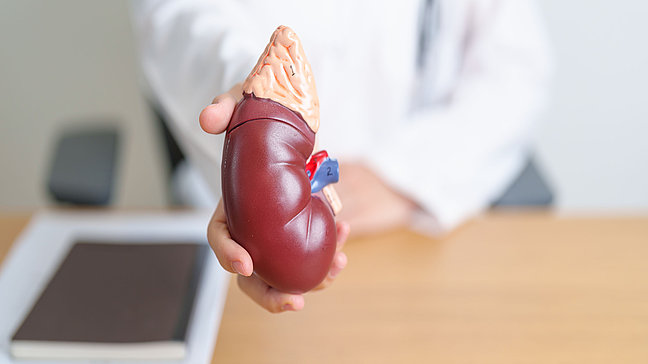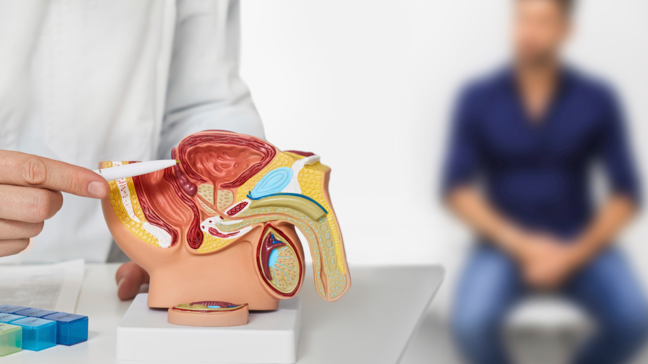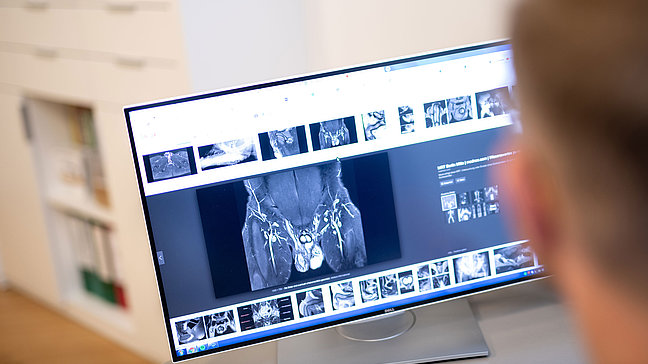
Seminom
Causes of seminoma
The exact cause of the development of seminomas is not fully understood, but some risk factors can increase the likelihood. The most important include:
Cryptorchidism (undescended testicles): Men whose testicles have not descended into the scrotum at birth have an increased risk of developing testicular cancer.
Genetic predisposition: A family history of testicular cancer increases the risk.
Previous testicular cancer: Men who have already had testicular cancer have a higher risk of developing a malignant disease in the other testicle.
Symptoms of seminoma
- Painless swelling or hardening in the testicle
- Feeling of heaviness or pressure in the scrotum
- Pain or discomfort in the lower abdomen, scrotum, or groin
- In rare cases, breast tenderness or enlargement (gynecomastia) due to hormonal changes
- Irregularities or lumps in the testicle that are discovered during a self-examination
Diagnosis of seminoma
The diagnosis usually begins with a physical examination of the testicle, during which the doctor looks for swelling, lumps, or hardening. An ultrasound of the testicle can be used to determine the size and type of the tumor. Blood tests to measure tumor markers such as alpha-fetoprotein (AFP), human chorionic gonadotropin (hCG), and lactate dehydrogenase (LDH) can also be helpful. A definitive diagnosis is made through a tissue biopsy, which often occurs after the removal of the affected testicle (orchiectomy).
Treatment options for seminoma
- Surgical Removal (Orchiectomy): The first and most important treatment method is the surgical removal of the affected testicle. This operation is usually curative.
- Radiation Therapy: Since seminomas are very sensitive to radiation, radiation therapy is often used after the operation to destroy remaining cancer cells, especially in early stages of the tumor.
- Chemotherapy: In advanced stages or when the cancer has spread (metastases), chemotherapy is often used. Seminomas respond well to this treatment, and the chances of cure are high even in advanced stages.
- Surveillance: In some cases, especially with small, early-detected seminomas, close monitoring without immediate further treatment may be considered after the removal of the testicle (orchiectomy).
Preventive measures for seminoma
Since the exact causes are not fully known, there are no specific preventive measures. However, men should perform regular self-examinations of the testicles to detect changes early. In the presence of risk factors such as cryptorchidism or a family history of testicular cancer, close medical monitoring is advisable.
Common Patient Questions About Seminoma
A seminoma can be detected early through regular self-examinations of the testicles. Any noticeable changes, such as hardening or swelling, should be immediately examined by a doctor. Ultrasound examinations and blood tests for tumor markers, such as beta-hCG, can also contribute to early detection.
The chances of curing a seminoma in its early stage are very high. With a combination of surgical removal of the affected testicle and, if necessary, additional radiation or chemotherapy, the cure rates are over 90%.
After the treatment of a seminoma, regular follow-up examinations are crucial to detect a possible recurrence at an early stage. These include physical examinations, blood tests for tumor markers, and imaging procedures such as ultrasound or CT scans, which are frequently performed in the first few years.
Risk factors for the development of a seminoma include undescended testicles in childhood, genetic predisposition, and family history. Additionally, seminoma occurs more frequently in younger men between the ages of 20 and 40.
![[Translate to English:]](/fileadmin/_processed_/1/d/csm_UZ-Logo-2024-breit-aK-1500px-white-red_4b49b8d28c.png)


